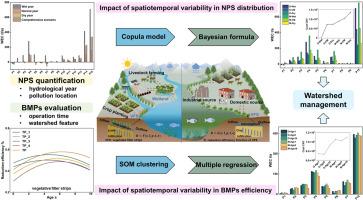整合非点源污染时空变异性与最佳管理实践效率以改善适应性流域管理
IF 12.4
1区 环境科学与生态学
Q1 ENGINEERING, ENVIRONMENTAL
引用次数: 0
摘要
非点源污染是造成水质退化的主要原因之一,具有明显的时空变异性,对水文条件变化下的流域管理提出了重大挑战。然而,大多数现有的控制策略依赖于静态假设,忽略了污染物负荷的动态变化以及最佳管理实践(BMPs)在时间和空间上的表现。本文以辽河流域为例,提出了时空变异对流域管理影响评估的新框架。结合Copula和Bayesian模型,提供了一个污染物负荷情景,该情景集成了bmp配置的多种水文条件,捕捉了流量和水质之间的非线性关系,以及相关的不确定性。此外,考虑到流域特征和运行持续时间的动态变化,利用自组织图结合多元回归对bmp效率进行了评估。结果表明,污染物分布的时间变化导致管理成本波动较大,干旱年管理成本增加38.91%,湿润年管理成本减少23.38%。空间变异性使控制面积扩大了25.99%,控制成本增加了31.98%。bmp效率的时空差异进一步影响了管理效益。5年运营期的管理成本最低,比1年和10年的管理成本分别低2.64%和21.70%。此外,bmp效率的空间变异使管理成本增加了15.55% ~ 28.97%。这些发现为支持在不断变化的环境条件下适应性bmp布局提供了定量见解,从而增强了流域管理的弹性。本文章由计算机程序翻译,如有差异,请以英文原文为准。

Integrating spatiotemporal variability of non-point source pollution and best management practice efficiency to improve adaptive watershed management
As a major contributor to water quality degradation, non-point source (NPS) pollution exhibits pronounced spatiotemporal variability, posing significant challenges to watershed management under changing hydrological conditions. However, most existing control strategies rely on static assumptions, neglecting dynamic variations in pollutant loading and the performance of best management practices (BMPs) across time and space. This study proposed a new framework to assess the impact of spatiotemporal variability on watershed management, using the Liao River watershed in China as a case study. Copula and Bayesian models were coupled to provide a pollutant load scenario that integrates multiple hydrological conditions for BMPs configuration, capturing the nonlinear relationship between flow and water quality, and the associated uncertainties. Moreover, BMPs efficiency was evaluated using a self-organizing map combined with multiple regression, accounting for dynamic changes across watershed characteristics and operational durations. The results demonstrated that temporal variability in pollutant distribution led to substantial fluctuations in management costs, with a 38.91% increase in dry years and a 23.38% decrease in wet years. The spatial variability expanded the required control area by 25.99% and increased the control cost by 31.98%. The spatiotemporal variation in BMPs efficiency further affected management benefits. A five-year operational period for BMPs yielded the lowest management costs, which were 2.64% and 21.70% lower than those for one-year and ten-year periods. Additionally, spatial variability in BMPs efficiency increased management cost by 15.55%-28.97%. These findings provide quantitative insights to support adaptive BMPs layout under changing environmental conditions, thereby enhancing resilience in watershed management.
求助全文
通过发布文献求助,成功后即可免费获取论文全文。
去求助
来源期刊

Water Research
环境科学-工程:环境
CiteScore
20.80
自引率
9.40%
发文量
1307
审稿时长
38 days
期刊介绍:
Water Research, along with its open access companion journal Water Research X, serves as a platform for publishing original research papers covering various aspects of the science and technology related to the anthropogenic water cycle, water quality, and its management worldwide. The audience targeted by the journal comprises biologists, chemical engineers, chemists, civil engineers, environmental engineers, limnologists, and microbiologists. The scope of the journal include:
•Treatment processes for water and wastewaters (municipal, agricultural, industrial, and on-site treatment), including resource recovery and residuals management;
•Urban hydrology including sewer systems, stormwater management, and green infrastructure;
•Drinking water treatment and distribution;
•Potable and non-potable water reuse;
•Sanitation, public health, and risk assessment;
•Anaerobic digestion, solid and hazardous waste management, including source characterization and the effects and control of leachates and gaseous emissions;
•Contaminants (chemical, microbial, anthropogenic particles such as nanoparticles or microplastics) and related water quality sensing, monitoring, fate, and assessment;
•Anthropogenic impacts on inland, tidal, coastal and urban waters, focusing on surface and ground waters, and point and non-point sources of pollution;
•Environmental restoration, linked to surface water, groundwater and groundwater remediation;
•Analysis of the interfaces between sediments and water, and between water and atmosphere, focusing specifically on anthropogenic impacts;
•Mathematical modelling, systems analysis, machine learning, and beneficial use of big data related to the anthropogenic water cycle;
•Socio-economic, policy, and regulations studies.
 求助内容:
求助内容: 应助结果提醒方式:
应助结果提醒方式:


